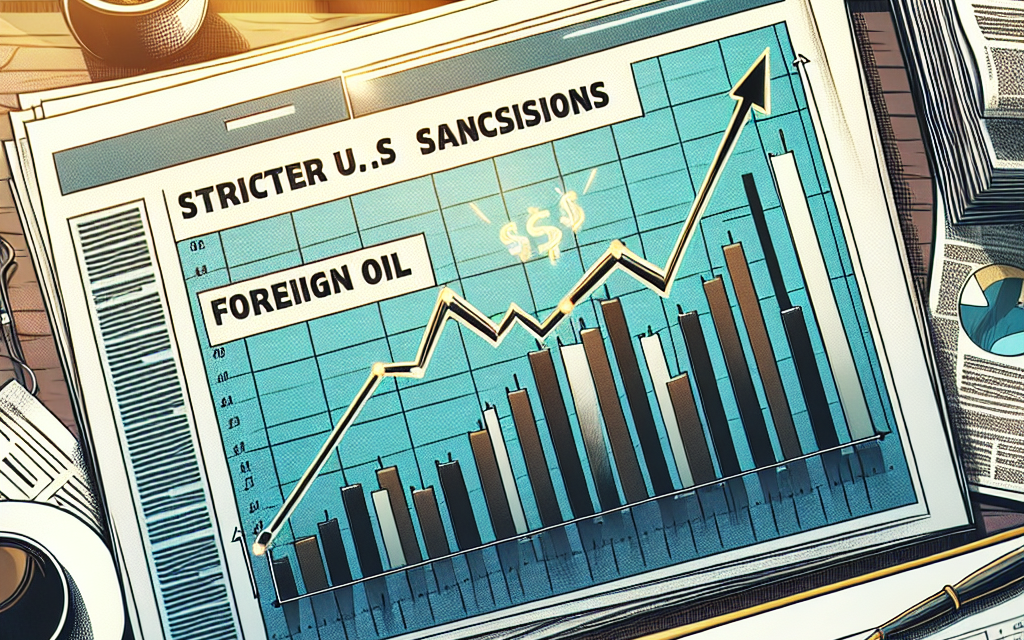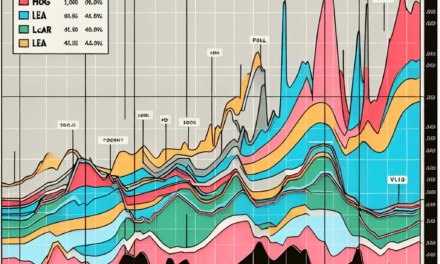“Oil Prices Soar 3% as US Tightens Grip on Russian Oil with Stricter Sanctions.”
Introduction
Oil prices surged by 3% in response to the implementation of stricter U.S. sanctions on Russian oil, reflecting heightened market concerns over supply disruptions. The sanctions, aimed at curbing Russia’s revenue from oil exports amid ongoing geopolitical tensions, have intensified fears of a tighter global oil market. As traders react to the potential for reduced Russian oil availability, the surge in prices underscores the fragility of the current energy landscape and the significant impact of geopolitical developments on commodity markets.
Impact of US Sanctions on Global Oil Markets
The recent surge in oil prices, which saw an increase of 3% following the announcement of stricter U.S. sanctions on Russian oil, underscores the intricate relationship between geopolitical events and global oil markets. As the United States intensifies its efforts to curb Russia’s oil exports in response to ongoing geopolitical tensions, the ramifications of these sanctions extend far beyond the borders of the two nations involved. The ripple effects are felt across the globe, influencing supply chains, pricing structures, and the overall dynamics of energy markets.
To begin with, the imposition of stricter sanctions on Russian oil is likely to exacerbate existing supply constraints in an already volatile market. Russia, being one of the world’s largest oil producers, plays a crucial role in the global supply chain. Consequently, any disruption to its oil exports can lead to significant fluctuations in oil prices. The recent sanctions are expected to limit Russia’s ability to sell its oil on the international market, thereby reducing the overall supply available to consumers worldwide. This reduction in supply, coupled with steady or increasing demand, creates a classic scenario of supply and demand imbalance, which is a primary driver of rising prices.
Moreover, the sanctions have prompted other oil-producing nations to reassess their production strategies. Countries that are not directly affected by the sanctions may find themselves in a position to capitalize on the situation. For instance, nations in the Middle East, such as Saudi Arabia and the United Arab Emirates, may increase their output to fill the void left by Russian oil. However, this potential increase in production is not guaranteed, as these countries often operate under OPEC+ agreements that limit output to stabilize prices. Thus, while some nations may seek to boost production, the overall response from the global oil community remains uncertain.
In addition to supply concerns, the sanctions have also led to increased speculation in the oil markets. Traders and investors are closely monitoring the situation, leading to heightened volatility as they react to news and developments surrounding the sanctions. This speculative behavior can further amplify price movements, creating a feedback loop where rising prices lead to more speculation, which in turn drives prices even higher. As a result, the oil market is currently characterized by a high degree of uncertainty, making it challenging for businesses and consumers to predict future costs.
Furthermore, the impact of these sanctions is not limited to oil prices alone; it also has broader implications for global economic stability. Higher oil prices can lead to increased costs for consumers and businesses alike, potentially stoking inflationary pressures in various economies. As energy costs rise, consumers may find themselves with less disposable income, which can dampen overall economic growth. Additionally, industries that rely heavily on oil, such as transportation and manufacturing, may face increased operational costs, leading to potential price hikes for goods and services.
In conclusion, the recent surge in oil prices following the announcement of stricter U.S. sanctions on Russian oil highlights the complex interplay between geopolitical actions and global oil markets. As supply constraints tighten and speculation increases, the ramifications of these sanctions are likely to be felt across the globe, influencing not only oil prices but also broader economic conditions. The situation remains fluid, and stakeholders in the energy sector must remain vigilant as they navigate the evolving landscape shaped by these geopolitical developments.
Analysis of Oil Price Trends Post-Sanctions
In recent weeks, the global oil market has experienced significant fluctuations, particularly following the announcement of stricter U.S. sanctions on Russian oil. The immediate aftermath of these sanctions saw oil prices surge by approximately 3%, reflecting the market’s sensitivity to geopolitical developments. This increase can be attributed to a combination of factors, including supply chain disruptions, shifts in demand, and the broader implications of the sanctions on global energy dynamics.
To begin with, the sanctions imposed by the United States are designed to limit Russia’s ability to export oil, which is a critical revenue source for the Russian economy. As these sanctions take effect, the anticipated reduction in Russian oil exports has raised concerns about supply shortages in an already tight market. Consequently, traders and investors have reacted swiftly, driving up prices as they factor in the potential for decreased availability of oil on the global stage. This reaction underscores the interconnectedness of geopolitical events and market responses, illustrating how political decisions can have immediate and far-reaching economic consequences.
Moreover, the surge in oil prices is not solely a reaction to the sanctions but also reflects ongoing trends in global energy consumption. As economies continue to recover from the impacts of the COVID-19 pandemic, demand for oil has rebounded significantly. This resurgence in demand, coupled with the prospect of reduced supply from Russia, has created a perfect storm for rising prices. In this context, the market is grappling with the dual pressures of recovering demand and constrained supply, leading to heightened volatility in oil prices.
In addition to these immediate factors, it is essential to consider the longer-term implications of the sanctions on global oil markets. The U.S. sanctions may prompt other countries to reevaluate their energy partnerships and sourcing strategies. For instance, nations that have historically relied on Russian oil may seek alternative suppliers, thereby reshaping trade flows and potentially leading to increased competition for oil from other regions. This shift could further exacerbate price volatility as markets adjust to new supply dynamics.
Furthermore, the sanctions may also accelerate the transition towards renewable energy sources. As countries look to reduce their dependence on Russian oil, there may be a renewed emphasis on investing in alternative energy technologies. This transition could have profound implications for the oil market in the long run, as demand for fossil fuels may decline in favor of more sustainable energy solutions. However, in the short term, the immediate impact of the sanctions is likely to keep oil prices elevated as markets adjust to the new reality.
In conclusion, the recent surge in oil prices following stricter U.S. sanctions on Russian oil highlights the intricate relationship between geopolitical events and market dynamics. The combination of anticipated supply shortages and recovering demand has created a volatile environment for oil prices. As the situation unfolds, it will be crucial for market participants to monitor not only the immediate effects of the sanctions but also the broader implications for global energy consumption and trade patterns. Ultimately, the evolving landscape of the oil market will require stakeholders to remain agile and informed as they navigate the complexities of an increasingly interconnected world.
The Role of Russian Oil in Global Energy Supply
The global energy landscape is intricately woven with the threads of supply and demand, and one of the most significant players in this arena is Russian oil. As one of the world’s largest producers, Russia has long been a critical supplier of crude oil, contributing to the stability and fluctuations of global oil prices. The recent surge of 3% in oil prices, following the announcement of stricter U.S. sanctions on Russian oil, underscores the profound impact that geopolitical events can have on energy markets. To understand this dynamic, it is essential to examine the role of Russian oil in the global energy supply chain.
Russian oil production has historically accounted for a substantial portion of the world’s crude output. In fact, Russia is often ranked among the top three oil producers globally, alongside the United States and Saudi Arabia. This positioning not only highlights Russia’s importance in meeting global energy demands but also illustrates the interconnectedness of international markets. When sanctions are imposed on Russian oil, as seen recently, the ripple effects are felt worldwide. Countries that rely heavily on Russian crude must seek alternative sources, which can lead to increased competition for available supplies and, consequently, higher prices.
Moreover, the sanctions imposed by the U.S. are not merely a domestic issue; they resonate across the globe. Many European nations, for instance, have historically depended on Russian oil to meet their energy needs. As these countries grapple with the implications of reduced access to Russian crude, they are forced to explore other avenues, such as increasing imports from other oil-producing nations or investing in renewable energy sources. This shift can create a temporary imbalance in supply and demand, further exacerbating price volatility in the oil market.
In addition to the immediate effects on supply, the sanctions also raise concerns about the long-term stability of the global energy market. The uncertainty surrounding Russian oil production and export capabilities can lead to speculative trading, where investors react to potential future scenarios rather than current realities. This speculation can drive prices higher, as traders anticipate shortages or disruptions in supply chains. Consequently, the volatility in oil prices can have far-reaching implications for economies worldwide, affecting everything from transportation costs to consumer prices.
Furthermore, the geopolitical landscape surrounding Russian oil is complex and multifaceted. Countries that oppose the sanctions may seek to capitalize on the situation by increasing their own oil production or by forming alliances with Russia to secure favorable trade agreements. This geopolitical maneuvering can further complicate the global energy supply chain, as nations navigate their own interests while responding to the shifting dynamics of oil availability.
In conclusion, the role of Russian oil in the global energy supply is pivotal, and the recent surge in oil prices following stricter U.S. sanctions serves as a stark reminder of this reality. As countries adjust to the implications of reduced access to Russian crude, the interconnectedness of global markets becomes increasingly evident. The fluctuations in oil prices not only reflect immediate supply and demand dynamics but also highlight the broader geopolitical tensions that shape the energy landscape. As the world continues to grapple with these challenges, the future of oil prices and the stability of global energy supply remain uncertain, underscoring the need for adaptive strategies in an ever-evolving market.
Economic Implications of Rising Oil Prices
The recent surge in oil prices, which increased by 3% following the announcement of stricter U.S. sanctions on Russian oil, has significant economic implications that reverberate across global markets. As countries grapple with the consequences of these sanctions, the immediate effect is a tightening of supply, which in turn drives prices higher. This increase not only affects consumers at the pump but also has broader ramifications for various sectors of the economy.
To begin with, higher oil prices typically lead to increased transportation costs. This is particularly relevant for industries reliant on logistics and supply chains, such as retail and manufacturing. As fuel costs rise, companies may face pressure to pass these expenses onto consumers, resulting in higher prices for goods and services. Consequently, inflationary pressures may intensify, leading central banks to reconsider their monetary policies. In an environment where inflation is already a concern, rising oil prices could prompt interest rate hikes, which would further impact borrowing costs for businesses and consumers alike.
Moreover, the surge in oil prices can exacerbate existing economic disparities. Low-income households, which allocate a larger portion of their budgets to energy and transportation, are particularly vulnerable to fluctuations in fuel prices. As their disposable income shrinks due to rising costs, these households may reduce spending on non-essential goods and services, thereby slowing economic growth. This situation creates a feedback loop where decreased consumer spending can lead to lower business revenues, potentially resulting in layoffs and further economic contraction.
In addition to domestic implications, the rise in oil prices has significant geopolitical ramifications. Countries that are heavily dependent on oil imports may find themselves in a precarious position, as their trade balances could deteriorate. For instance, nations in Europe, which have been striving to reduce their reliance on Russian energy, may face increased energy costs that could hinder their economic recovery post-pandemic. This scenario could lead to a reevaluation of energy policies and a push for alternative energy sources, thereby accelerating the transition to renewable energy. However, such transitions require time and investment, and in the short term, countries may struggle to adapt to the new economic landscape.
Furthermore, the oil price surge can have a mixed impact on oil-producing nations. While higher prices can bolster the revenues of these countries, particularly those in the Middle East and North America, they can also lead to increased scrutiny and potential backlash from the international community. For instance, nations that rely on oil exports may face pressure to stabilize prices or increase production to alleviate the burden on importing countries. This dynamic can create tensions within OPEC and other oil-producing alliances, as member countries navigate their national interests against the backdrop of global economic stability.
In conclusion, the recent rise in oil prices due to stricter U.S. sanctions on Russian oil carries profound economic implications that extend beyond immediate market reactions. As consumers and businesses adjust to higher costs, the potential for inflationary pressures looms large, prompting central banks to reconsider their strategies. Additionally, the geopolitical landscape may shift as countries reassess their energy dependencies and seek alternative solutions. Ultimately, the interplay between rising oil prices and the global economy underscores the intricate connections that define our modern world, highlighting the need for adaptive strategies in an ever-evolving economic environment.
Strategies for Consumers Amidst Increasing Fuel Costs
As oil prices surge by 3% in response to stricter U.S. sanctions on Russian oil, consumers are increasingly feeling the impact of rising fuel costs. This situation necessitates a proactive approach to managing expenses related to transportation and energy consumption. In light of these developments, it is essential for consumers to explore various strategies that can help mitigate the financial burden associated with escalating fuel prices.
One of the most effective strategies for consumers is to reassess their transportation habits. Carpooling, for instance, can significantly reduce the number of vehicles on the road, thereby lowering individual fuel consumption. By sharing rides with colleagues or friends, consumers not only save on fuel costs but also contribute to reducing traffic congestion and environmental pollution. Additionally, utilizing public transportation can be a cost-effective alternative, especially in urban areas where commuting by bus or train may be more economical than driving a personal vehicle.
Moreover, consumers should consider the benefits of adopting fuel-efficient driving practices. Simple adjustments, such as maintaining a steady speed, avoiding rapid acceleration and hard braking, and ensuring that tires are properly inflated, can lead to improved fuel efficiency. According to various studies, these practices can enhance a vehicle’s miles per gallon (MPG) performance, ultimately resulting in lower fuel expenses over time. Furthermore, regular vehicle maintenance, including oil changes and air filter replacements, can also contribute to optimal fuel efficiency, making it a worthwhile investment for consumers looking to save on fuel costs.
In addition to modifying transportation habits, consumers can explore alternative modes of transportation. Bicycling or walking for short distances not only reduces fuel consumption but also promotes a healthier lifestyle. For those who live in areas conducive to biking or walking, this shift can lead to significant savings on fuel while simultaneously enhancing physical well-being. Furthermore, electric vehicles (EVs) are becoming increasingly accessible and affordable, offering consumers a long-term solution to rising fuel costs. With advancements in battery technology and the expansion of charging infrastructure, transitioning to an EV can provide substantial savings on fuel expenses in the long run.
Another strategy for consumers is to evaluate their energy consumption at home. As fuel prices rise, so too do the costs associated with heating and cooling. Implementing energy-efficient practices, such as using programmable thermostats, sealing windows and doors, and utilizing energy-efficient appliances, can help reduce overall energy consumption. Additionally, consumers may consider investing in renewable energy sources, such as solar panels, which can provide long-term savings on energy bills while also contributing to environmental sustainability.
Lastly, consumers should stay informed about market trends and potential government assistance programs. Awareness of fluctuations in fuel prices and available subsidies can empower consumers to make informed decisions regarding their energy consumption and transportation choices. By remaining vigilant and adaptable, consumers can navigate the challenges posed by rising fuel costs while minimizing their financial impact.
In conclusion, as oil prices continue to rise due to geopolitical tensions and sanctions, consumers must adopt a multifaceted approach to manage their fuel expenses effectively. By reassessing transportation habits, embracing fuel-efficient practices, exploring alternative modes of transport, and optimizing energy consumption at home, individuals can mitigate the financial strain of increasing fuel costs. Through informed decision-making and proactive strategies, consumers can navigate this challenging landscape while maintaining their financial stability.
Geopolitical Factors Influencing Oil Prices
The recent surge in oil prices, which saw an increase of 3% following the announcement of stricter U.S. sanctions on Russian oil, underscores the intricate relationship between geopolitical factors and global energy markets. As nations navigate the complexities of international relations, the implications for oil prices become increasingly pronounced. The sanctions, aimed at curbing Russia’s revenue from oil exports amid ongoing geopolitical tensions, have not only affected the targeted nation but have also reverberated throughout the global oil market.
To understand the dynamics at play, it is essential to recognize that oil is a commodity heavily influenced by supply and demand, which are often swayed by geopolitical events. In this context, the U.S. sanctions serve as a critical factor that disrupts the established flow of oil from Russia, one of the world’s largest oil producers. As these sanctions take effect, the immediate consequence is a tightening of supply in an already volatile market. This reduction in available oil leads to increased prices, as buyers scramble to secure alternative sources of energy.
Moreover, the sanctions have broader implications for global energy security. Countries that rely heavily on Russian oil are now faced with the challenge of finding new suppliers, which can lead to increased competition for available resources. This competition further exacerbates the upward pressure on prices, as nations seek to fill the void left by Russian exports. Consequently, the interconnectedness of global markets means that a decision made in Washington can have far-reaching effects on oil prices in Europe and beyond.
In addition to the direct impact of sanctions, other geopolitical factors also play a significant role in shaping oil prices. For instance, ongoing conflicts in the Middle East, particularly in oil-rich regions, can lead to supply disruptions that affect global markets. Similarly, political instability in key oil-producing countries can create uncertainty, prompting traders to react swiftly to potential threats to supply. This volatility is often reflected in fluctuating oil prices, as market participants adjust their expectations based on the latest developments.
Furthermore, the role of OPEC (Organization of the Petroleum Exporting Countries) cannot be overlooked in this discussion. OPEC’s decisions regarding production levels are often influenced by geopolitical considerations, and any changes in output can significantly impact oil prices. For example, if OPEC decides to cut production in response to geopolitical tensions, the resulting decrease in supply can lead to higher prices, further complicating the already delicate balance of the market.
As we analyze the current landscape, it becomes evident that the interplay between geopolitical factors and oil prices is complex and multifaceted. The recent surge in prices following U.S. sanctions on Russian oil is a clear illustration of how political decisions can have immediate and profound effects on global markets. In this environment, market participants must remain vigilant, as the geopolitical landscape continues to evolve, influencing not only oil prices but also broader economic conditions.
In conclusion, the surge in oil prices serves as a reminder of the significant impact that geopolitical factors can have on energy markets. As nations grapple with the consequences of their foreign policy decisions, the ripple effects are felt across the globe, highlighting the intricate connections between politics and economics. Understanding these dynamics is crucial for stakeholders in the energy sector, as they navigate an increasingly complex and uncertain landscape.
Future Outlook for Oil Prices and Sanctions Policy
The recent surge in oil prices, which saw an increase of 3% following the announcement of stricter U.S. sanctions on Russian oil, has raised significant questions about the future trajectory of global oil markets and the implications of ongoing sanctions policies. As geopolitical tensions continue to shape the energy landscape, analysts are closely monitoring how these developments will influence supply and demand dynamics in the coming months.
The imposition of stricter sanctions on Russian oil is a strategic move by the U.S. aimed at curtailing Russia’s revenue streams, particularly in light of its ongoing military actions. This policy shift is expected to have immediate repercussions on global oil supply, as Russia is one of the world’s largest oil producers. With the U.S. and its allies tightening the screws on Russian exports, the potential for a supply crunch looms large. Consequently, this situation is likely to drive prices higher, as markets react to the uncertainty surrounding Russian oil availability.
Moreover, the ripple effects of these sanctions extend beyond just Russian oil. Countries that have historically relied on Russian energy supplies may find themselves scrambling to secure alternative sources. This shift in demand could lead to increased competition for oil from other producers, particularly in the Middle East and North America. As a result, prices may not only rise due to the direct impact of sanctions but also because of the broader market adjustments that follow.
In addition to supply constraints, the demand side of the equation is also critical to consider. The global economy is still in a recovery phase from the pandemic, and as countries ramp up industrial activity, the demand for oil is expected to increase. This resurgence in demand, coupled with the potential for reduced supply from Russia, creates a perfect storm for higher oil prices. Furthermore, as nations transition towards renewable energy sources, the pace of this transition will also play a role in shaping future oil demand. If the shift to renewables accelerates, it could dampen long-term oil prices, but in the short term, the immediate effects of sanctions are likely to overshadow these considerations.
Looking ahead, the effectiveness of U.S. sanctions will depend on the level of compliance from other nations and the ability of Russia to adapt to these restrictions. If major consumers of Russian oil, such as China and India, continue to purchase oil despite sanctions, the intended impact may be mitigated. Conversely, if these countries align with the sanctions, the resulting supply shock could lead to even steeper price increases.
In conclusion, the future outlook for oil prices in the wake of stricter U.S. sanctions on Russian oil is fraught with uncertainty. While immediate price surges are likely as markets react to potential supply disruptions, the longer-term implications will hinge on a complex interplay of geopolitical factors, global demand trends, and the responses of both producers and consumers. As the situation evolves, stakeholders across the energy sector will need to remain vigilant, adapting their strategies to navigate the shifting landscape of oil prices and sanctions policy. The coming months will be critical in determining how these dynamics unfold and what they mean for the global economy at large.
Q&A
1. **Question:** What caused the recent surge in oil prices?
**Answer:** The surge in oil prices was caused by stricter US sanctions on Russian oil.
2. **Question:** By how much did oil prices increase following the sanctions?
**Answer:** Oil prices increased by 3%.
3. **Question:** Which country’s oil exports are primarily affected by the US sanctions?
**Answer:** Russia’s oil exports are primarily affected.
4. **Question:** What is the potential impact of these sanctions on global oil supply?
**Answer:** The sanctions could lead to a tighter global oil supply, driving prices higher.
5. **Question:** How do stricter sanctions on Russian oil affect market sentiment?
**Answer:** Stricter sanctions create uncertainty in the market, leading to increased speculation and higher prices.
6. **Question:** What are some potential consequences for consumers due to rising oil prices?
**Answer:** Consumers may face higher fuel prices and increased costs for goods and services.
7. **Question:** How might these sanctions influence other oil-producing countries?
**Answer:** Other oil-producing countries may increase production to fill the gap left by Russian oil, potentially stabilizing prices.
Conclusion
The surge in oil prices by 3% following the implementation of stricter US sanctions on Russian oil highlights the market’s sensitivity to geopolitical developments. These sanctions are likely to disrupt supply chains and create uncertainty in the global oil market, leading to increased prices as traders react to potential shortages and shifts in supply dynamics. This situation underscores the interconnectedness of global energy markets and the impact of political decisions on commodity prices.





